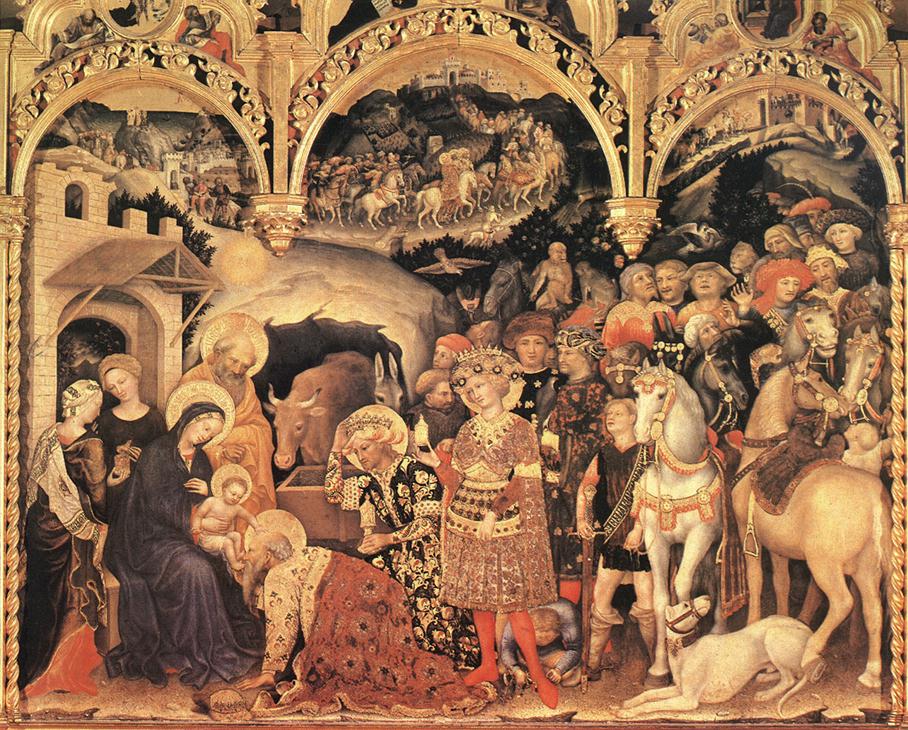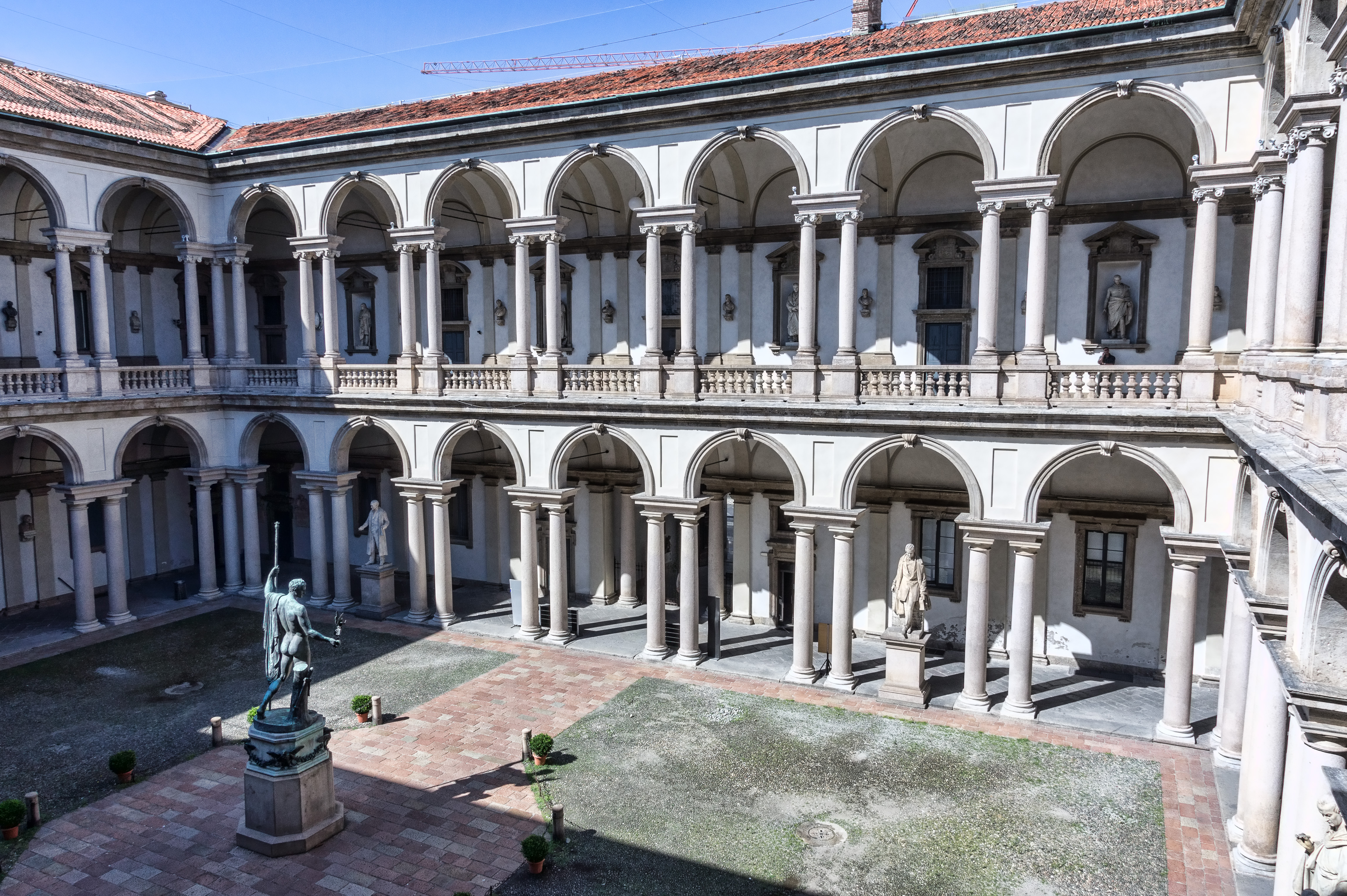|
Master Of Staffolo
The Master of Staffolo (active 1420–1460) was an anonymous late-Gothic style painter active in the region of Marche and Umbria. He appears to have been influenced by Gentile da Fabriano, the brothers Salimbeni of San Severino Marche, and Bartolomeo di Tommaso of Foligno. Attributed to this painter are many works including: Fabriano, short biography. *Painting for Sant'Egidio, Staffolo *Painting for Convent of the Beata Mattia in |
Gothic Art
Gothic art was a style of medieval art that developed in Northern France out of Romanesque art in the 12th century AD, led by the concurrent development of Gothic architecture. It spread to all of Western Europe, and much of Northern, Southern and Central Europe, never quite effacing more classical styles in Italy. In the late 14th century, the sophisticated court style of International Gothic developed, which continued to evolve until the late 15th century. In many areas, especially Germany, Late Gothic art continued well into the 16th century, before being subsumed into Renaissance art. Primary media in the Gothic period included sculpture, panel painting, stained glass, fresco and illuminated manuscripts. The easily recognizable shifts in architecture from Romanesque to Gothic, and Gothic to Renaissance styles, are typically used to define the periods in art in all media, although in many ways figurative art developed at a different pace. The earliest Gothic art was monumental ... [...More Info...] [...Related Items...] OR: [Wikipedia] [Google] [Baidu] |
Marche
Marche ( , ) is one of the twenty regions of Italy. In English, the region is sometimes referred to as The Marches ( ). The region is located in the central area of the country, bordered by Emilia-Romagna and the republic of San Marino to the north, Tuscany to the west, Umbria to the southwest, Abruzzo and Lazio to the south and the Adriatic Sea to the east. Except for river valleys and the often very narrow coastal strip, the land is hilly. A railway from Bologna to Brindisi, built in the 19th century, runs along the coast of the entire territory. Inland, the mountainous nature of the region, even today, allows relatively little travel north and south, except by twisting roads over the passes. Urbino, one of the major cities of the region, was the birthplace of Raphael, as well as a major centre of Renaissance history. Toponymy The name of the region derives from the plural of the medieval word '' marca'', meaning "march" or "mark" in the sense of border zone, origin ... [...More Info...] [...Related Items...] OR: [Wikipedia] [Google] [Baidu] |
Umbria
it, Umbro (man) it, Umbra (woman) , population_note = , population_blank1_title = , population_blank1 = , demographics_type1 = , demographics1_footnotes = , demographics1_title1 = , demographics1_info1 = , demographics1_title2 = , demographics1_info2 = , demographics1_title3 = , demographics1_info3 = , timezone1 = CET , utc_offset1 = +1 , timezone1_DST = CEST , utc_offset1_DST = +2 , postal_code_type = , postal_code = , area_code_type = ISO 3166 code , area_code = IT-55 , blank_name_sec1 = GDP (nominal) , blank_info_sec1 = €22.5 billion (2018) , blank1_name_sec1 = GDP per capita , blank1_info_sec1 = €25,400 (2018) , blank2_name_sec1 = HDI (2018) , blank2_info_sec1 = 0.884 · 12th of 21 , blank_name_sec2 = NUTS Region , blank_info_sec2 = ITE , ... [...More Info...] [...Related Items...] OR: [Wikipedia] [Google] [Baidu] |
Gentile Da Fabriano
Gentile da Fabriano ( – 1427) was an Italian painter known for his participation in the International Gothic painter style. He worked in various places in central Italy, mostly in Tuscany. His best-known works are his ''Adoration of the Magi'' from the ''Strozzi Altarpiece'' (1423), and the ''Flight into Egypt''. Following a visit to Florence in the 1419, he came in contact with humanism, which influenced his work throughout the rest of his career. He became highly influential for other painters in Florence, especially because of his use of detail based on the observations he made of the natural world. Bibliography Early life in Fabriano (c. 1370-1400) Gentile (di Niccolò di Massio) da Fabriano was born around 1370 in or near Fabriano, in the Marche. Despite having several family members who took part in different civic and religious organizations in the city, much of Gentile's early life remains undocumented. His mother died some point before 1380, and his father, Nicco ... [...More Info...] [...Related Items...] OR: [Wikipedia] [Google] [Baidu] |
San Severino Marche
San Severino Marche is a ''comune'' (municipality) in the Province of Macerata in the Italian region Marche, located about southwest of Ancona and about southwest of Macerata. History From prehistory to Roman age The oldest remains of human presence in San Severino date back to the Palaeolithic and their provenance is from the area of Stigliano. But there are other remains, found in many localities of the communal territory, documenting several settlements in the area in different ages. In the Serralta territory, north of San Severino, characteristic remains from the medium Palaeolithic and High Palaeolithic have been found whereas human presence in Pitino, located north-east of the town, goes back to the medium Musterianum Palaeolithic.Metallic remains with a symbolic function were found in many areas of the communal territory, documenting the uninterrupted settlement and the existence of a complex social hierarchy of the whole prehistoric era. The first significant civiliza ... [...More Info...] [...Related Items...] OR: [Wikipedia] [Google] [Baidu] |
Bartolomeo Di Tommaso
Bartolomeo di Tommaso, also known as Bartolomeo da Foligno (born in Foligno, c. 1400, active by 1425, died 1453–54) was an Italian painter of the Umbro- Sienese school. Life and career He was in Ancona from 1425 to 1442, when he returned to Foligno with his wife, Onofria, the sister of the painter Pierantonio Mezzastris. Bartolomeo was documented in Norcia in 1442, at work in the choir of Sant’ Agostino with a group of painters, including Nicola di Ulisse from Siena; Luca di Lorenzo from Germany; Giambono di Corrado of Ragusa; and Andrea de Litio Andrea de Litio (active 1442–1473) was an Italian painter. His city of birth is uncertain; one possibility is Lecce nei Marsi in the Province of L'Aquila in the Abruzzo. He was active mainly in the Abruzzo. Documents from 1442 have him worki .... The administration of Pope Nicholas V asked him to come to Rome and work in various projects. [...More Info...] [...Related Items...] OR: [Wikipedia] [Google] [Baidu] |
Santa Maria Maddalena, Matelica
Santa Maria Maddalena, also called the Chiesa della Beata Mattia is a Baroque-style, Roman Catholic church and monastery located on a cul de sac of Via Beata Mattia #39, where it intersects with Via Damiano Chiesa, in Matelica, province of Macerata, region of Marche, Italy. History The church is among the oldest in Matelica and construction began in 1225, when a group of Clarissine nuns, including Sister Mattia, established a convent. In 1765, the Sister was beatified, and the church is known for '' Blessed Mattia''. The church has a tall campanile, which served as an overlook for the southern approach to the city. An earthquake in 1740 caused major damage, and in 1750, the church underwent a major reconstruction, including the formulation of a baroque façade, work commissioned by Enrico Mattei and using designs of Gaetano Maggi and Domenico Luigi Valeri. The interiors were built still maintaining a screened separation of the cloistered nuns from the lay public. The columns ... [...More Info...] [...Related Items...] OR: [Wikipedia] [Google] [Baidu] |
Matelica
Matelica is a (municipality) of the Province of Macerata in the Italian region of Marche. Located about southwest of Ancona and west of Macerata, it extends over an area of . Geography Matelica lies in an ample valley where the Braccano creek joins the Esino river, dominated by the town from an eastern ravine. The valley, roughly in the north–south direction, is delimited on the east and west sides by Apennines sub-ranges, whose highest peaks are respectively Mount Gemmo at and Mount San Vicino at , compared to the above sea-level of the city centre. Matelica borders on the following municipalities: Apiro, Castelraimondo, Cerreto d'Esi, Esanatoglia, Fabriano, Fiuminata, Gagliole, Poggio San Vicino, San Severino Marche. Climate The climate is dictated by the Apennines and, to a lesser extent, by the temperate Adriatic Sea on the east. Consequently, Matelica enjoys a somewhat continental climate with cool winters and hot, dry summers. In winter, Matelica o ... [...More Info...] [...Related Items...] OR: [Wikipedia] [Google] [Baidu] |
Fabriano Cathedral
Fabriano Cathedral ( it, Duomo di Fabriano, Cattedrale di San Venanzio) is a Roman Catholic cathedral in Fabriano, Italy, dedicated to San Venanzio (Saint Venantius of Camerino). It is the seat of the Bishop of Fabriano-Matelica. History and description The present church was built in the 14th century and rebuilt in 1607–1617 in a Baroque restoration, including stucco decoration and paintings by Gregorio Preti, Salvator Rosa, Giovanni Francesco Guerrieri, Giuseppe Puglia and Orazio Gentileschi. The apse belongs to the original 14th-century cathedral as do the cloister and the St Lawrence Chapel with frescoes (c. 1360) by Allegretto di Nuzio. The church has also frescoes depicting the ''Story of the True Cross'' (1415) by Giovanni di Corraduccio. SourcesWebsite of the Diocese of Fabriano-Matelica: the parish of the cathedral Website of the Diocese of Fabriano-Matelica: history of the cathedralwww.settembreorganistico.it: the organ Cathedral A cathedral is a c ... [...More Info...] [...Related Items...] OR: [Wikipedia] [Google] [Baidu] |
Fabriano
Fabriano is a town and ''comune'' of Ancona province in the Italian region of the Marche, at above sea level. It lies in the Esino valley upstream and southwest of Jesi; and east-northeast of Fossato di Vico and east of Gubbio (both in Umbria). Its location on the main highway and rail line from Umbria to the Adriatic make it a mid-sized regional center in the Apennines. Fabriano is the headquarters of the giant appliance maker Indesit (partly owned by Whirlpool). Fabriano, with Roma, Parma, Torino and Carrara, is an Italian creative city (UNESCO). The town is in the category ''Folk Arts'' (for the Fabriano's handmade paper production). History Fabriano appears to have been founded in the early Middle Ages by the inhabitants of a small Roman town south at Attiggio (Latin ''Attidium''), of which some slight remains and inscriptions are extant. Fabriano itself was one of the earliest places in Europe to make high-quality paper on an industrial scale, starting in the 13t ... [...More Info...] [...Related Items...] OR: [Wikipedia] [Google] [Baidu] |
Pinacoteca Civica Di Fabriano
A pinacotheca (Latin borrowing from grc, πινακοθήκη, pinakothēkē = grc, πίναξ, pinax, (painted) board, tablet, label=none + grc, θήκη, thēkē, box, chest, label=none) was a picture gallery in either ancient Greece or ancient Rome. The name is specifically used for the building containing pictures which formed the left wing of the Propylaea on the Acropolis at Athens, Greece. The Pinacotheca was located next to the temple of Athena Nike. Though Pausanias speaks of the pictures "which time had not effaced",Pausanias, ''Description of Greece''book I, chapter xxii, page 31, section 6 translated by J. G. Frazer (1898) which seems to point to fresco painting, the fact that there is no trace of preparation for stucco on the walls implies that the paintings were easel pictures. The Romans adopted the term for the room in a private house containing pictures, statues, and other works of art. In the modern world the word is often used as a name for a public art g ... [...More Info...] [...Related Items...] OR: [Wikipedia] [Google] [Baidu] |







